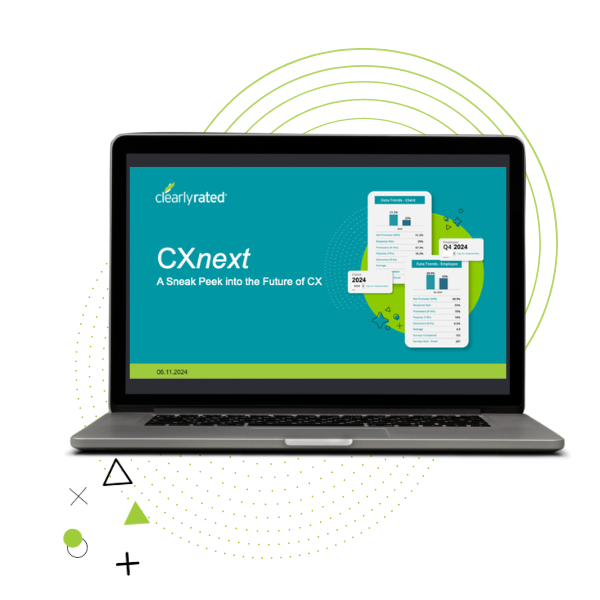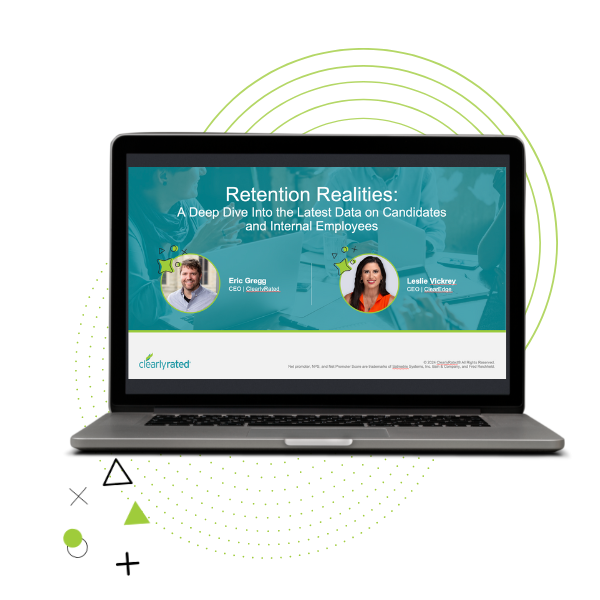Today, nearly every client experience in nearly every business service sector is driven or supported by rapidly-evolving digital technology. And as more firms invest in initiatives that measure and improve the client experience (commonly known as ‘CX initiatives’), we are seeing the significant impact of technological innovation on the implementation and outcomes of CX strategy.
In our work as a client experience research firm as well as a client satisfaction survey provider, we’ve long enjoyed a multi-industry, cross-border view of the issues that are at the cutting edge of CX strategy for business service firms. And while there are hundreds of CX solutions clamoring for executive attention (and investment dollars), there are 5 technological trends we expect will serve as leading indicators for the solutions that will deliver outsized impact today, and keep your firm at the cutting edge of CX for years to come.
Here are our top 5 technological trends to watch for business service firms investing in a CX initiative:
- Integrations (i.e. integrating client feedback data into your client database): Integrations are rapidly becoming the way of life in our software-empowered world. Businesses realize the exponential power that can be derived from data that exists beyond just one piece of technological “real estate.”
Similarly, we are seeing integrations make waves in the CX space. The question, “Where does the client feedback data live?” draws a line in the sand between gate-keeping and democratizing access to that data. For example, most firms engaged in a CX program employ digital survey software to gather feedback from their clients. But if that survey data doesn’t make it into the platforms where your client-facing team can see it, weigh it, and take action on it (think CRM or ATS systems), then the CX program is cutting itself short on impact.More than that, integrating client feedback data into other business databases provides insight into deeper relationships between client sentiment (as recorded in your survey), client behavior (like contract size and renewal history), and client demographics (like the client’s industry, team size, and annual revenue). These side-by-side data points, and the trends that can be built when they are tracked together over time, offer a remarkable opportunity for forward-thinking firms to build a CX-centered business plan. - Automation (i.e. automating surveys to capture client feedback at critical moments): Just like integrations can help democratize access to client feedback data, they can also help reduce the amount of manual effort that goes into launching a survey, especially when it comes to identifying the right clients to invite feedback from and when to trigger that request.
Let me take a step back… It’s common for businesses starting out with a CX program to conduct an annual or quarterly survey, “timing” the ask for feedback around a larger business cycle. This strategy makes sense for garnering feedback on the overall relationship with a client, especially when there is a great deal of effort that goes into moving through a single feedback cycle. Typically, most of this effort is spent sourcing, scrubbing, and finalizing client contact lists, and requires a team member (sometimes even an entire team) to manage the process to collect these critical insights from clients.
Survey automation changes all of that. Through automated survey programs, businesses are able to trigger automatic surveys from their CRM or ATS database to specific clients at specific “moments in time.” You can ask questions that are tailored to each specific client and the critical moment that triggered the survey (i.e. onboarding, mid-contract, end-of-engagement, renewal, etc.), providing a number of new opportunities to gather critical intelligence on the client experience. - Predictive Analytics (i.e. leveraging client feedback for predictive modeling): In the section highlighting integrations, I touched on the benefits of merging client data sets to develop a more holistic view of a client’s behavior and sentiment profile. But that’s just the beginning. Beyond analyzing 1-to-1 relationships between client feedback and behavior, or even historical trends between them, there is an opportunity to mine these data sets in a way that develops predictive indicators that can help your firm model out future-state revenue. You can also use analytics to understand how resource allocation may impact a given client’s experience and willingness to continue working with your firm.
One powerful example comes from my friends at Rehmann, a top 50 accounting and advisory firm, with locations across 3 states. They run a comprehensive, automated client survey program, but aren’t content to stop at “how are we doing?”. They also look at engagement levels in other ways, such as email, phone or in-person meetings, registration for webinars, and time-since-last-contact to develop a more fully formed understanding of their clients’ engagement. Wilson Allen, a consulting firm that helps professional service firms improve business performance, works alongside firms like Rehmann to help build and connect an entire ecosystem of engagement data to their core processes, putting the keys to growth in front of each partner in real-time.
Many firms are barely scratching the surface of the predictive intelligence that can be mined across client data sets. This will most certainly be an area of investment and expansion in the world of CX for professional service providers. - Online reputation (i.e. translating client feedback into online ratings and reviews): Online ratings and reviews are a growing interest for providers of professional services. Since the onset of COVID-19, in-person connection and word-of-mouth marketing are more difficult to come by. Your brand’s online presence, and the virtual thoughts and feelings shared by your clients, significantly impact your chances of sourcing new opportunities and winning new clients.
Leading-edge programs tie their CX initiatives directly to online reputation strategy. Working from real customer feedback, these firms drive new, validated online ratings and reviews to deliver more credible proof of the service they provide in the channel where prospects spend the majority of their time researching—online. Today this looks like adding functionality to your survey program that asks clients to rate you on your target websites (perhaps Google, Yelp, or Glassdoor if you’re focused on surveying employees). Some firms go further by investing in client feedback programs like G2 and ClearlyRated that automatically translate client satisfaction scores into online star ratings on a validated and indexed rating site. With prospective buyers increasingly turning to online research, and consistently trusting information from your existing clients more than any sales or marketing you could publish, we expect this technology trend to drive the future of CX strategy in an outsized way. - Mobile-first technology (i.e. centering mobile design and user experience in CX): Believe it or not, mobile technologies (i.e. smartphones) likely represent your firm’s primary channel for client engagement. Many other consumer-based industries have been fast to adopt this strategy, but business service providers have moved more slowly to adopt a mobile-first mindset and prioritize the mobile user experience in their CX strategy.
In a survey conducted by Adobe, 92% of respondents consider their smartphone to be their primary device. In many firms, a shift towards mobile has already happened (or is happening) related to digital marketing efforts, but what does this look like for CX initiatives? First and foremost, ensure that any content you ask your clients to interact with, like surveys or third-party applications, are designed with mobile in mind (responsive design is the gold standard). You could even think about mobile as a separate communication channel from the web. Many CX technologies enable texting (in addition to emailing survey invitations) to supplement feedback campaigns, meeting clients where they are most likely to pay attention and improving engagement and responsiveness to survey requests.
For further information regarding technology trends and how they will impact the future of CX, please feel free to contact ClearlyRated—our expert team would be happy to walk through how we can assist your firm in designing a CX strategy for sustained ROI!





